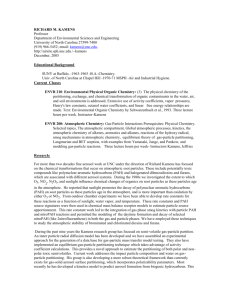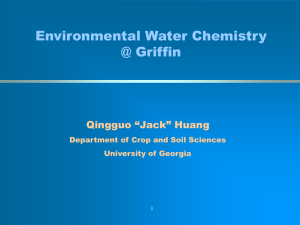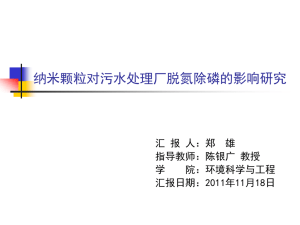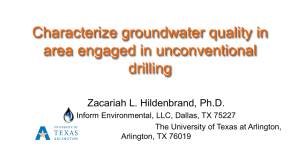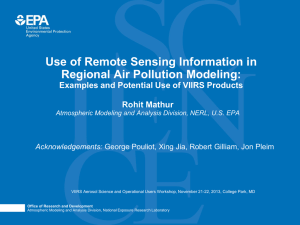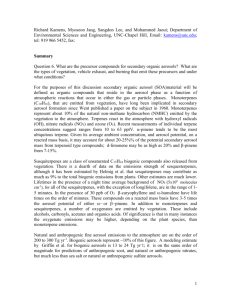Curriculum Vitae - UNC Gillings School of Global Public Health
advertisement
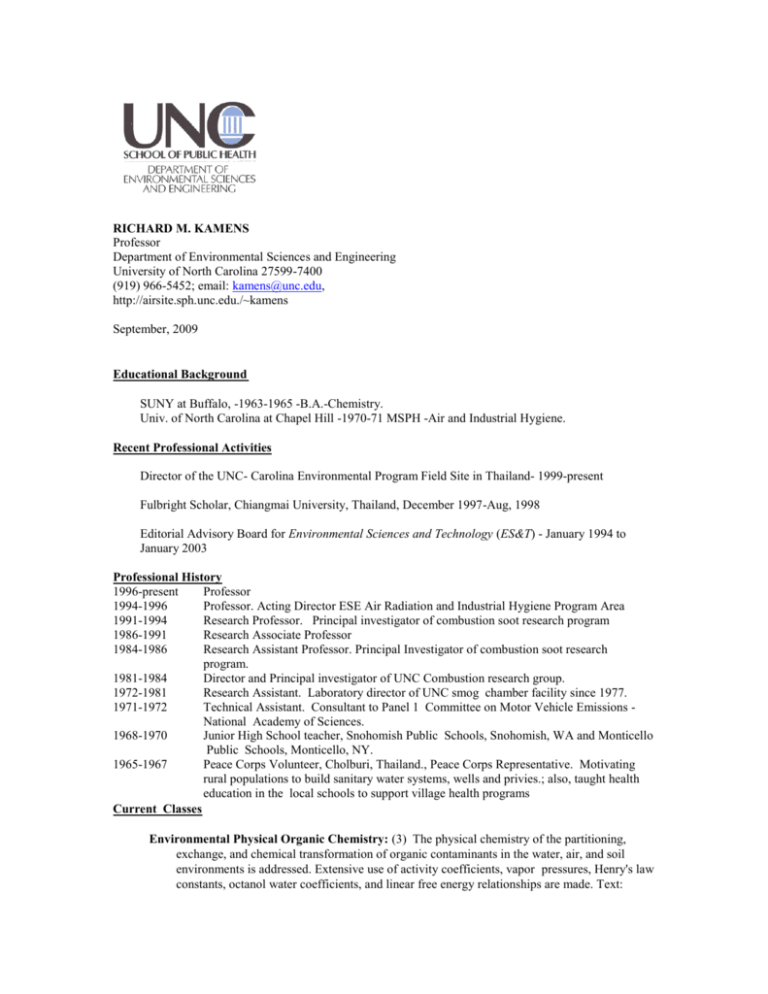
RICHARD M. KAMENS Professor Department of Environmental Sciences and Engineering University of North Carolina 27599-7400 (919) 966-5452; email: kamens@unc.edu, http://airsite.sph.unc.edu./~kamens September, 2009 Educational Background SUNY at Buffalo, -1963-1965 -B.A.-Chemistry. Univ. of North Carolina at Chapel Hill -1970-71 MSPH -Air and Industrial Hygiene. Recent Professional Activities Director of the UNC- Carolina Environmental Program Field Site in Thailand- 1999-present Fulbright Scholar, Chiangmai University, Thailand, December 1997-Aug, 1998 Editorial Advisory Board for Environmental Sciences and Technology (ES&T) - January 1994 to January 2003 Professional History 1996-present Professor 1994-1996 Professor. Acting Director ESE Air Radiation and Industrial Hygiene Program Area 1991-1994 Research Professor. Principal investigator of combustion soot research program 1986-1991 Research Associate Professor 1984-1986 Research Assistant Professor. Principal Investigator of combustion soot research program. 1981-1984 Director and Principal investigator of UNC Combustion research group. 1972-1981 Research Assistant. Laboratory director of UNC smog chamber facility since 1977. 1971-1972 Technical Assistant. Consultant to Panel 1 Committee on Motor Vehicle Emissions National Academy of Sciences. 1968-1970 Junior High School teacher, Snohomish Public Schools, Snohomish, WA and Monticello Public Schools, Monticello, NY. 1965-1967 Peace Corps Volunteer, Cholburi, Thailand., Peace Corps Representative. Motivating rural populations to build sanitary water systems, wells and privies.; also, taught health education in the local schools to support village health programs Current Classes Environmental Physical Organic Chemistry: (3) The physical chemistry of the partitioning, exchange, and chemical transformation of organic contaminants in the water, air, and soil environments is addressed. Extensive use of activity coefficients, vapor pressures, Henry's law constants, octanol water coefficients, and linear free energy relationships are made. Text: Environmental Organic Chemistry by Schwarzenbach et al., 1993. Three lecture hours per week. Instructor-Kamens Atmospheric Chemistry: Gas-Particle Interactions Prerequisites: Physical Chemistry. Selected topics, The atmospheric compartment, Global atmospheric processes, kinetics, the atmospheric chemistry of alkenes, aromatics and alkanes, reactions of the hydroxy radical, smog mechanisms in atmospheric chemistry, equilibrium theory of gas-particle partitioning, Langmurian and BET sorption, with examples from Yamasaki, Junge, and Pankow, and modeling gas-particle reactions. Three lecture hours per week- Instructors Kamens Undergraduate Environmental Chemistry: Highlight some important areas in environmental chemistry, and present some of the common techniques that environmental chemists use to quantify process that occur in the environment. We will cover general topics that include: global warming, stratospheric. O3, aerosols, photochemical smog, acid rain, pesticides and heavy metals in the environment: We will develop simple relationships will be used to help quantify equilibrium and kinetic processes It is assumed that everyone has courses in calculus and general chemistry. Three lecture hours per week- Instructors Kamens Research: For almost three decades fine aerosol work at UNC under the direction of Richard Kamens has focused on the chemical transformations that occur on atmospheric soot particles. These include potentially toxic compounds like polynuclear aromatic hydrocarbons (PAH) and halogenated dibenzodioxins and furans, which are associated with different aerosol systems. During the 1980s his group investigated the extent to which O3, NO2, N2O5, and sunlight influence chemical changes of organics on soot particles as these particles age in the atmosphere. He reported that sunlight promotes the decay of polynuclear aromatic hydrocarbons (PAH) on soot particles as these particles age in the atmosphere, and is more important than oxidation by either O3 or NO2. From outdoor chamber experiments we have been able to develop rate constants for these reactions as a function of sunlight, water vapor, and temperature. These rate constants and PAH source signatures were then used in chemical mass balance receptor models to estimate particle source apportionment. This rate constant work led to the integration of gas phase smog kinetics with particle PAH and nitroPAH reactions and permitted the modeling of the daytime formation and decay of selected nitroPAH (like 2nitrofluoranthene) in both the gas and particle phases. His group has employed these techniques to study the atmospheric stability of brominated and chlorinated dioxins and furans. During the past 10 years the Kamens research group has focused on semi-volatile gas-particle partition. An inner particle radial diffusion model has been developed and we have assembled an experimental approach for the generation of a data base for gas-particle mass transfer model testing. They also have implemented an equilibrium-gas-particle partitioning technique which takes advantage of activity coefficient calculations. This provides a novel approach to estimate the partitioning of both polar and nonpolar toxic semivolatiles. He and is group have developed a kinetics model to predict aerosol formation from biogenic hydrocarbons. This integrates gas and particle phase chemistry and equilibrium partitioning thermodynamics. This model has been successfully used to predict secondary aerosol formation (SOA) from -pinene and d-limonene +O3 dark systems and NOx + light systems. This model has most recently been expanded to toluene and is currently being adapted to other aromatic SOA systems, isoprene and mixtures of terpenes, isoprene, and aromatics. Last, he has helped implement, along with Dr. Pojanie of KMUTT (King Mongkut’s Univeristy of Technology) and Dr. Suwasa of CMU (Chiang Mia University) an undergraduate/graduate student exchange/research program in Thailand and currently serves as the UNC field site coordinator. UNC students spend 6+ months in Thailand taking classes and working onr research projects. Their Thai counterparts spend a semester at UNC in our graduate program. The 1 st group of students began studies at KMUTT in June, 2001 and stayed thought December, 2001. At KMUTT and CMU the UNC students teamed with Thai graduated students and taking three classes in 1. Environmental Chemistry, 2. Environmental Modeling/air pollution, and 3.Environemntal Risk Analysis/Modeling. After completion of the classes, the UNC-Thai student group spend 2-3 months addressing a significant environmental problem, which was formulated during their class work. The project for the year 2001- and 2002 was the “Feasibility of Ethanol Production in Thailand.” Individuals in the group worked on: types of possible crops/biomass that potentially can be used for ethanol production; GIS mapping of transportation systems, crops, population densities and available land; the economics of generating ethanol versus selling biomass crops directly; modeling ethanol-vehicle impacts on the Bangkok atmosphere; and evaluation of current and future ethanol technologies, costs of production, and policy and market incentives. The group that went over in 2002 looked at the energy balance associated with the ethanol production in Thailand and modeled the impact of ethanol fuel replacement on ozone formation in Bangkok. They found that given the available ethanol technology, ethanol productions was energy negative and would considerably impact Bangkok smog if used on a large scale. In 2003 the group looked at PAH partitioning, SO 2 deposition and lead exposures. The 2004 group investigated the feasibility of bio-diesel as and energy source in South East Asia. The energy life cycle analysis approach demonstrated that unlike ethanol, biodiesel production was energy favorable, and if fully implemented could provide a significant fraction of Bangkok’s petroleum diesel needs. In 2007 the group conducted a land use and economic study of biofuel use in Thailand. They estimated that at most only 10% of the available agricultural land in Thailand could be used for biofuels up to 2020 after which it would start to cut into food production. Modeling of the Bangkok atmosphere suggested increases of ground based O3 with a 10% substitution of biofuel use. Grants and Contracts “A Kinetic Model for predicting Secondary Organic Aerosol Formation in Complex Hydrocarbon Mixtures” Aug 1 2007, NSF, Funded July 31 2010,PI-Kamens, $548,000 “Secondary Aerosol Formation from Gas and Particle Phase Reactions of Aromatic Hydrocarbons” USEPA STAR program, funded, August 2003 to August 2006, PI-Kamens, $400,000 “Atmospheric Secondary Aerosol Formation by Acid-catalyzed Heterogeneous Reactions of Carbonyls” NSF, funded, August, 2003 to August 2006, PI-M. Jang, co-PI, R. Kamens, $500,000 “A Predictive Model for Biogenic Hydrocarbon Aerosol Formation Using a Gas Phase Kinetic-Aerosol Partitioning Approach” NSF; funded, July 2001-June 2004, PI- R. Kamens, $527,000 “Predicting Day and Nighttime Aerosol Yields from Biogenic Hydrocarbons with a Gas –Particle Phase Kinetic Model, EPA Star Program Sorting Code: 99-STAR-R2: PI- R. Kamens” funded: 09-01 to 08-03, $225, 000 “Partitioning of Semivolatile Organic Compounds: Organic and Inorganic Aerosols:” A unified Approach, USEAPSTAR Program, PI Kamens, PI, 9-15-98 to 9-14-2001 , $562, 536 “The partitioning of Semi-volatile Organics,” NSF, PI, Kamens, 7-1-97 to-6-30-2000, $320,00. “Continued Environmental Investigations of Organo-silicon compounds” PI R. Kamens, Dow Corning Corp. 1997, $30,000 “An Experimental Data Base and Modeling Effort to Describe the Atmospheric Gas-Aerosol Mass Transfer of Semivolatile Organics, NSF, PI, Kamens ,9-15-94 to-14-97, 365,00. “Environmental Investigations of Organo-silicon compounds” PI R. Kamens, Dow Corning Corp. 7- 94 to . 9-96 , $100,000 "Modeling the Transfer of Semi-volatles Organics in Combustion Aerosols" North Carolina Super computing Center, PI, Kamens1-1-94 to 12-31-95, $100,000 “Predicting Day and Nighttime Aerosol Yields from Biogenic Hydrocarbons with a Gas –Particle Phase Kinetic Model, EPA Star Program Sorting Code: 99-STAR-R2: PI- R. Kamens” funded, 09-01 to 08-02, 225K "Cooperative Research Between the Chinese, USEPA & UNC Scientists" USEPA, P.I., -R. Kamens, 09/29/92 to 2/28/94. $94,000. "Atmospheric Transformations of Halogenated Dibenzo-p-Dioxins and Dibenzofurans" 3/15/91 to 3/14/94. USEPA, Office of Exploratory Research PIs-M.J. Charles & R. Kamens. $438,000" Heterogeneous Organic Reactions on Atmospheric Aerosols," 09/24/90 to 09/23/93. USEPA, Office of Exploratory Research PIs- S McDow & R. Kamens. $430,000 "Indoor and Outdoor Aerosols - Characterization Studies" 09/01/88 to 6/14/92. USEPA P.I. -R. Kamens. $343,000. "A Methodology for Analyzing Hazardous Waste From Incineration and Other Treatment Alternatives", 03/0l/89 to 8/30/91. P.I. Kamens, Charles, Amaral. From Hazardous Substance Research Under North Carolina State University. $226,000. "Cooperative Research Between the Chinese, USEPA & UNC Scientists" USEPA, P.I., -R. Kamens, 08/22/88 to 5/15/92. $374,000. "UNC, Chapel Hill-China-US EPA Joint Research Program", PI- R. Kamens, Environmental Protection Agency, 10/1/85 to 9/30/88, $205,185. "Atmospheric Behavior of PAH, Nitro PAH and Aromatic Carbonyls on Airborne Soot Particles," PI- R Kamens, Office of Exploratory Research, Environmental Protection Agency, 7/15/85 to 7/14/87, $246,773. "Analysis of Benzo(l)aceanthrylene in Wood Soot Samples," PI- R Kamens, Environmental Protection Agency, 3/29/85 to 2/28/86, $9,999. "Aging Emissions from Residential Coal Combustion in Environmental Chambers," PI- R Kamens, Environmental Protection Agency, 3/29/85 to 12/30/85, $9,605. "OH Rate Constant Intercomparison Study," PI- R Kamens, Northrop Research Services, 5/17/85 to 9/30/85, $21,000 "Atmospheric Reactions and Atmospheric Mutagenic Changes in Emissions from Common Fuels," PI- R Kamens, Office of Exploratory Research, Environmental Protection Agency, 10/1/83 to 9/30/85, $149,991. "The Atmospheric Transformation and Bioactivity of Combustion Products from Residential Wood Stoves," PI- R Kamens, Office of Exploratory Research, Environmental Protection Agency, 6/1/81 to 12/31/83, $220,030. "The Atmospheric Transformation and Bioactivity of Combustion Products from Residential Wood Stoves," PI- R Kamens, State of North Carolina, 4/1/81 to 12/31/83, $28,110. . Peer Reviewed Journal Publications Kamens, R. M.; Stern, A.C. "Effects of Inclusion or Exclusion of Methane in the 1975 Automobile Standard for Hydrocarbons," J. Air Pollut. Assoc., 23, 593-596, 1973. Fox, D. L.; Kamens, R.M; Jeffries,H.E; "Photochemical Smog Systems: Effect of Dilution on Ozone Formation," Science, 118, 1113, 1973. Jeffries, H. E.; Fox, D.L; Kamens, R.M. "Photochemical Conversion of NO to NO2 by Hydrocarbons in An Outdoor Chamber," J. Air Pollut. Assoc., 10, 1006-1011, 1976. Jeffries, H. E.; Fox, D.L.; Kamens, R.M. "Outdoor Smog Chamber Studies: Light Effects Relative to Indoor Chambers," Environ. Sci. Technol., 10,1006-1011, 1976. Kamens, R. M.; Jeffries, H.E.; Fox, D.L.;.Alexander, L. "Potential Effect of Emission Control Strategies on Nighttime NO2 Concentrations," Atmos. Environ., 11, p. 22, 1977.. Wright, R. S.; Kamens, R.M.; Sickles, J.E.; Jeffries, H.E.; Eaton, W.C. "Comparison Between Two Outdoor Smog Chamber Facilities: Matched Experiments," J. Air Pollut. Assoc., 26, 249-250, 1978. Kamens, R. M.; Jeffries, H.E.; Gery, M.W.; Wiener, R.W.; Sexton, K.G; Howe, G.B. "The Impact of a-pinene on Urban Smog Formation: An Outdoor Smog Chamber Study," Atmos. Environ., 15, pp. 969-981, 1981 Kamens, R. M.; Jeffries, H.E.; Sexton, K.G.; Wiener, R.W. "The Impact of Day-Old Dilute Smog on Fresh Smog Systems," Atmos. Environ., 16, pp. 1027-1034, 1982. Feigley, C. E.; Jeffries, H.E.; Kamens, R.M. "An Experimental Simulation of Los Angeles Reactive Pollutant Program (LARPP) Operation 33-Part I: Experimental Simulation in an Outdoor Smog Chamber," Atmos. Environ., 16,1987-1986, 1982. Kamens, R. M.; Gery, M.W.; Jeffries, H.E.; Jackson, M.; Cole, E.I. "Ozone Isoprene Reactions Product Formation and Aerosol Potential," Int. J Chem. Kinet.,14, pp. 955-975, 1982. Feigley, C. E.; Kamens, R.M.; Jeffries, H.E. "Experimental Simulation of Los Angeles Reactive Pollutant Program (LARPP) Operation 33-II. Evaluation of Simulation," Atmos. Environ., 17, 103-109, 1983. Saucy, D. A.; Kamens, R.M.; Linton, R.W. "An Aerosol Injection and Outdoor Chamber System for the Study of Atmospheric Gas-Particle Reactions," Atmos. Environ., 17, 2617-2624, 1983. Kamens, R. M.; Rives, G.D.; Perry, J.M.; Bell, D.A.; Paylor, R. F. Jr.; Claxton, L.D. "Mutagenic and Chemical Changes in Dilute Wood Smoke As It Ages and Reacts with O3, NO2 in the Dark - An Outdoor Chamber Study," Environ. Sci. Technol., 18, 523-530, 1984. Kamens, R. M.; Bell, D.A.; Perry, J.M.; Goodman, R.G.; Dietrich, A.; Tejada, S. "Airborne Mutagenic Transformations of Dilute Wood Smoke Systems: Analysis of Selected HPLC Fractions from Wood Smoke Particle Extracts," Environ. Sci. Technol., 19, 63-70, 1985. Kamens, R. M.; Perry, J.M.; Saucy, D.A.; Bell, D.A.; Newton, D.L.; Brand, B. "Factors Which Influence PAH Decomposition on Airborne Wood Smoke Particles," Environ. Internat., 11, 131-136, 1985. Bell, D. A.; Kamens, R.M. "Photodegradation of Wood Smoke Mutagens," Atmos. Environ., 20, 318-321. Kamens, R. M., Fulcher, J.N.; Guo, Z. "Effects of Temperature on Wood Soot PAH Decay in Atmospheres with Sunlight and Low NOX," Atmos. Environ., 20. 1579-1587, 1986. Ackerman, T. P.; Guo, Z.; Kamens, R.M. "Equilibrium Temperatures of Aerosol Particles in Outdoor Exposure Chambers," Atmos. Environ. 20, 2473-2475, 1986. Gery, M. W., Fox, D.L.; Kamens, R.M.; Stockburger, L. "Investigation of Hydroxyl Radical Reactions with o-xylene and m-xylene in a Continuous Stirred Tank Reactor," Environ. Sci. Technol., 21, 339-348, 1987. Kamens, R. M., Fulcher, J.N.; Ball, L.M.; Gold, A. "Analysis of Cyclopenta Fused Isomers of Benz(a)Anthracene in Wood Smoke," Biomed. Environ. Mass Spect., 14, 369-374, 1987. Kamens, R. M., Guo, Z.; Fulcher, J.N.; Bell, D.A. "The Influence of Humidity and Temperature on the Daytime Decay of PAH on Atmospheric Soot Particles," Environ. Sci. Technol.., 22, 103-108, 1988.. Kamens, R. M.; Karam, H.; Guo, Z.; Perry, J.; Stockburger, L. "The Behavior of Oxy-PAH on Atmospheric Soot Particles," Environ. Sci. Technol..., 23, 801-806, 1989. Kamens, R., J. Guo, J.; Guo, Z. "PAH and N205 Reactions on Atmospheric Soot Particles," Atmos. Environ., 24A, 1161-1173, 1990. Bell, D., Kamens, R. "Evaluation of the Mutagenicity of Combustion Particles from Several common biomass fuels in the Ames/Salmonila Microsome Test," Mut.Res. Letters, 254, 177-183. 1990. Bell, D., Karam H.; Kamens,R. "A Nonaqueous Ion Exchange Separation Technique for Use in Bioassay-Directed Fractionation of Complex Mixtures: Application to Wood Smoke Particle Extracts," Environ. Sci. Technol., 24, 1261-1264, 1990. Kamens. R., Lee C.L.; WienerR.; Leith D., "A Study to Characterize Indoor Particles in Three Non-Smoking Homes," Atmos. Environ., 25A 939-948, 1991. Guo, Z., Kamens R. "An Experimental Technique for Studying Heterogeneous Reactions of Polyaromatic Hydrocarbons on Particle Surfaces," J. Atmos. Chem., 12, 137-151. 1991. Rodes, C., Kamens, R.; Wiener,R. "The Significance and Characteristics of Personal Cloud on Exposure Assessment Measurements for Indoor Contaminants," Indoor Air, 2, 123-145, 1991. Lutes, C, Charles, M.;J.; Odum,J.R.; Kamens, R.M. "Chamber Aging Studies of the Atmospheric Stability of Polybrominated Dibenzo-p-dioxins and Dibenzofurans" Environ. Sci. Technol.. 26, 991-998, 1992. Lutes, C.C.; Charles, M. J. ; Kamens R. M. “The atmospheric stability of polybrominated dibenzo-p-dioxins and dibenzofurans” Chemosphere, 25, 99-102. 1992 McDow, S., R. Sun, Q.; Vartianinen, M.K.; Hong,Y.; Yao,Y.; Hayes, E.A.; Kamens, R.M. "Photodegradation of Polycyclic Aromatic Hydrocarbons in Hexadecane and Methoxyphenols" Polycyclic Aromatic Compounds,vol 3 supplement, 111-118, 1993. Li, C.; Kamens R. "The Use of Polycyclic Aromatic Hydrocarbons as Source Signatures in Receptor Modeling", Atmospheric Environment, 27A, 523-532, 1993. Kamens R.M., Fan, Z.; Yao, Y.; Chen, D.; Chen, S.; Vartiainen M. "A Methodology for Modeling the Formation and Decay of Nitro-PAH in the Atmosphere" Chemosphere 28, #9, 1623-1632, 1994. Odum, J.R.; McDow; S.R.; Kamens, R.M. " Mechanistic and Kinetic Studies of the Photodegredatiuon of Benz(a)anthracene in the Presence of Methoxy Phenols" Environ. Sci. Technol., 28, 1285-1290, 1994. Birla,P. Kamens, R.M. "Effects of Combustion Temperature on the Atmospheric Stability of Polybrominated Dibenxxo-p-dioxins and dibenzofuirnas" Environ.Sci Technol. , 28,1437-1443, 1994. Odum, J. R.; Yu, J; Kamens, R.M. "Modeling the Mass Transfer of Semi-volatile Organics in Combustion Aerosols Environ. Sci. Technol., 28, 2278-2285, 1994. McDow R.; Sun, Q.; Vartiaiinen, M.; Hong,Y.; Yao,Y.; Fister, T.; Yao, R. Kamens,R.M. "The Effect of Organic Composition on Polycyclic Aromatic Hydrocarbons Decay in Atmospheric Aerosols" Environ. Sci Technol. 28, 2147-2153, 1994. Vartiainen, M.; McDow, S.R.; Kamens, R.M. “ Water Uptake by Aerosol Particles From Automobile Exhaust and Wood Smoke” Chemosphere 29,1661-1669, 1994. Kamens, R.; Odum; J.R.; Fan, Z. "Some Observations on the Times to Equilibrium For Semi-Volatile Polycyclic Aromatic Hydrocarbons" Environ. Sci. Technol., 29, 43-50, 1995. McDow, S.R., Vartiainen, M.; Sun Q.; Hong, Y.; Yao, Y.; Kamens, R.M. (1995)“Combustion Aerosol Water Content and It Effect on Polycyclic Aromatic Hydrocarbon Reactivity” Atmos. Environ. 29, 791-797 Fan Z., D. Chen, P Birla, R,M. Kamens “Modeling of Nitro-Polycyclic Aromatic Hydrocarbon Formation and Decay in the Atmosphere” Atmos, Environ. 29, 1171-1181, 1995. Fan Z.; Kamens, R.M.Kamens; J. Hu, and J. Zhang. (1996) “Photostability of Nitro-Polycyclic Aromatic Hydrocarbons on combustion Particles in Sunlight” Environ. Sci. Technol., 30, 1358-1364 Vartiainen, S.R.McDow, R. M. Kamens "Water Uptake by Sunlight and Ozone Exposed Diesel Exhaust Particles, Chemosphere, 32, 1319-1325, 1996. Mcdow S.R., M. Jang, Y. Hong, R.M. Kamens “An approach to Studying the Effect of Organic Composition on Atmopsheric Aerosol Photochemistry” J. Geophys. Res. 101, 19593-19600, 1996. Fan Z., Kamens R. M., Zhang J. and Hu J. “Ozone-Nitrogen Dioxide-NPAH Heterogeneous Reactions and A More Complete Mechanism to Model NPAH in the Atmosphere” Environ. Sci. Technol., Environ. Sci. Technol., 30, 2821-2827, 1996. Pennise D. , Kamens. R.M “ Effects of Combustion Temperature on the Atmospheric Stability of Chlorinated Dibenzo Dioxiins and Furans” Environ. Sci. Technol., 30, 2832-2842, 1996. Kamens, R.M., Coe, D.L.; “A large Gas-Phase Stripping Device to Investigate Rates of PAH Evaporation from Airborne Diesel Soot Particles” Environ. Sci. Technol, 31, 1830-1833, 1997. Jang, M.; Kamens, R. M.; Leach, B. K.; Michael, R. S. “A Thermodynamic Approach Using Group Contribution Methods to Model The Partitioning of Semi-volatile Organic Compounds on Atmospheric Particulate Matter” Environ. Sci. Technol. 31, 2805-2811, 1997. Strommen, M. R.; Kamens, R. M. “Development and Application of a Dual-Impedance Radial Diffusion Model to Simulate the Partitioning of Semivolatle Organic Compounds in Combustion Aerosols” Environ. Sci. Technol, 31, 2983-2990, 1997. Jang, M.; Kamens, R. M.; “A Thermodynamic Approach for Modeling Partitioning of Semivolatile Organic Compounds on Atmospheric Particulate Matter: Humidity Effects” Environ. Sci. Technol, 32, 12371243, 1998. Latimer, H.; Kamens, R.M.; Chandra G. “The Atmospheric Partitioning of Decamethycyclopentasiloxane (D5) and 1hydroxynonamethyl siloxane (D4TOH), on Different Types of Atmospheric Particles” Chemsophere , 36,2410-2414, 1998. Feilberg, A.; Kamens R. M., Strommen M. R. and Nielsen T “Modeling the Formation, Decay, and Partitioning of 1and 2-Nitronaphthalene in the Atmosphere” Atmos. Environ. 33/8, 1231-1243,1998 Jang, M.; R. M. Kamens (1999) “Newly Characterized Products and Composition of Secondary Aerosols from the Reaction of -Pinene with Ozone” Atmos. Environ., 3, 459-479, 1999 Jang, M.; R. M. Kamens "A Predictive Model for Adsorptive Gas Partitioning of SOCs on Fine Atmospheric Inorganic Dust Particles" Environ. Sci. Technol, 33, 33, 1825-1831, 1999 Kamens, R. M.; Jang, M.; Leach, B. K.; M R. Strommen; Chien,C “Aerosol Formation from the Reaction of -pinene and Ozone using a Gas Phase Kinetics-Aerosol Partitioning Model” Environ. Sci. Technol, 33, 14311438, 1999 Leach, K.B.; Kamens R.M., Strommen M. R.; Jang M. “Atmospheric Partitioning of Semivolatile Organic Compounds in the Presence of a Secondary Organic Aerosol, J. Atmos. Chem, 33,241-264, 1999 Strommen, M. R.; Kamens, R. M. “Simulation of Semi-volatile Organic Compound Transport at Different Time Scales in Atmospheric Diesel Soot Particles” Environ. Sci. Technol, 33, 1762-1771, 1999 Chandramouli, B.; Kamens, R.; “The Photochemical Formation and Gas-Particle Partitioning of Oxidation Products of Decamethyl Cyclopentasiloxane and Decamethyl Tetrasiloxane in the Atmosphere”, Atmos. Environ. 35, 87-95, 2001. Kamens R.M.; Jaoui M.; “Modeling Aerosol Formation from -pinene + NOx in the Presence of Natural Sunlight Using Gas Phase Kinetics and Gas-particle Partitioning Theory”, Environ. Sci. Technol. 35, 1394-1405, 2001 Jaoui, M.; Kamens, R.M.; “ Mass Balance of Gaseous and Particulate Products analysis from -Pinene + NOx in the presence of natural Sunlight”, J. Geophys. Res., 106,12541-12558, 2001. Jang, M.; Kamens, R.M.; “Characterization of Secondary Aerosol from the Photooxidation of Toluene in the Presence of NOx and 1-Propene,” Environ. Sci. Technol. 35, 3626-3639, 2001 Jang, M., Kamens; R.M, “Atmospheric Secondary Aerosol Formation by Heterogeneous Reactions of Aldehydes in the Presence of a Sulfuric Acid Aerosol Catalyst”, Environ. Sci. Technol. 35, 4758-4766, 2001 Vinitketkumnuen,U.; Kalayanamitra, K.; Chewonarin, T.; Kamens, R. Particulate Matter, PM 10 & PM 2.5, Levels and Airborne Mutagenicity in Chiang Mai, Thailand” , Mutation Research, 519/1-2, 121-131, 2002 Erik Teinemaa,E.; Kirso U.; Strommen, M.R; Kamens, R.M, “Atmospheric Behavior of Oil Shale Combustion Fly Ash in a Simulated Study”, Atmos. Environ., 36, 813-824, 2002. Jang, M.; Czoschke, N.M.; Lee, S.; Kamens, R. M.; “Heterogeneous Atmospheric Organic Aerosol Production by Inorganic Acid-Catalyzed Particle-Phase Reactions”, Science, 298, 814-817, October 25, 2002. Chandramouli, B.; Jang, M.; Kamens, R. "Gas-Particle Partitioning of Semi-volatle Organics on Organic Aerosols Using a Predictive Activity Coefficient Model: Analysis of the Effects of Parameter Choices on Model Performance", Atmos. Environ. 27, 853-864,2003. Jaoui, M.; Kamens, R.M.; “Photolysis Study of Gas Phase Pinonaldehyde in the Presence of Natural Sunlight” Atmos. Environ., 37, 1835-1851, 2003. Jaoui, M.; Kamens, R.M.; “Mass Gaseous and Particulate Oxidation Products of the reaction from a mixture of pinene + -pinene/O3/Air in the absence of light and -pinene + -pinene/NOx/Air in the presence of Natural Sunlight,” 44, 259-297, J. Atmos. Chem., 2003. Jang, M.; Lee, S.; Kamens, R. M.; “Organic Aerosol Growth by Acid-Catalyzed Heterogeneous Reactions of Octanal in a Flow Reactor”, Atmos. Environ., 37, 2125-2138, 2003. Jaoui, M.; Kamens, R.M.; Mass Balance of Gaseous and Particulate Products from -Pinene/O3/ air in the absence of light and -Pinene/NOx/ in the presence of natural Sunlight” J. Atmos. Chem., 43, 101-141,2003. Jaoui, M.; Leungsakul, S.; Kamens, R.M Gas and Particulate Products Distribution from the Reaction of Caryophyllene with Ozone, J. Atmos. Chem., 45, 216-287, 2003. Chardramouli, B.; Jang, M.; Kamens, R.M.; “Gas Particle Partitioning of Semi-Volatle Organics (SOCs) on Mixtures of Aerosols in a Smog Chamber”, Environ. Sci. Technol ,37, 4113-4121, 2003. Jang M.; Carroll, B.; Chandramouli, B.; Kamens R.M. “Particle Growth by Acid-catalyzed Heterogeneous Reactions of Organic Carbonyls on Pre-existing Aerosols”; Environ. Sci. Technol, 37,3828-3837, 2003. Jaoui, M.; Kamens, R.M.; “Gas and particulate products distribution from the photooxidation of -humulene in the presence of NOx, natural atmospheric air and sunlight, J. Atmos. Chem, 46. 29-54, 2003. Czoschke, N.M.; Jang, M.; Kamens R.M.; Effect of Acidic Seed on Biogenic Secondary Organic Aerosol Growth, Atmos. Environ, 37, 4287-4299, 2003. Tolocka M. P.; Jang M.; Ginter J.M.; Cox F.J.; KamensR.M. Johnston, M. Formation of Oligomers in Secondary Organic Aerosol, Environ. Sci. Technol. 38, 1426-1434, 2004 Jaoui, M.; Sexton, K.; Kamens, R.M. “Reaction of -Cedrene with Ozone: Mechanism, Gas and Particulate Products Distribution” Atmos. Environ. 38, 2709, 2004. Lee. S.; Jang, M.; R. Kamens “SOA Formation from the Photooxidation of -Pinene in the Presence of Freshly Emitted Diesel Soot Exhaust. Atmos. Environ., 38, 2579, 2604, 2004. Sexton, K.G.; Jeffreis. H.E.; Jang, M.: Kamens, R.M; Doyal, M.; Voicu, I “Photochemical Products of Urban Mixtures Enhance Inflammatory Responses in Lung Cells”, InHal, Tox, 16(suppl.) , 1-8, 2004 Dalton C.; Jaoui M.; Kamens,R.; Glish, G. Continuous real-time analysis of gas and particulate products from the reaction of some monoterpenes with ozone using Atmospheric Sampling Glow Discharge Ionization coupled to a Quadrupole Ion Trap Mass Spectrometer. Anal. Chem, 77, 3156-3163, 2005 Lee, S.; Kamens, R. M. “ Particle Nucleation from the Reaction of -Pinene and O3” Atmospheric Environment, 39, 6822-6832, 2005 Leungsakul, S.; Jeffries, H.E.; Kamens, R.M. “A Kinetic Mechanism for Predicting Secondary Aerosol Formation from the Reaction of d-limonene with NOX and Natural Sunlight”, Atmos. Environ., 39, 7063-7082 2005. Leungsakul, S.; Jaoui, M.; Kamens, R. M. “A Kinetic Mechanism for Predicting Secondary Aerosol Formation from the Reaction of d-limonene with Ozone” Environ. Sci. Technol. 39, 9583-9594, 2005. Lee, S.; Kamens, R.; Jang, M.; “Gas and Particle Partitioning Behavior of Aldehydes in the Presence of Diesel Soot and Wood Soot Aerosols. J. Atmos. Chem, 51 (2): 223-234, 2005 Li, Q., Hu D., Leungsakul S., Kamens, R.M., Large Outdoor Chamber Experiments and Computer Simulations: (I) Secondary Organic Aerosol Formation from the Oxidation of a Mixture of d-Limonene and α-Pinene, Atmos Environ., 41 .9341-9352, 2007 Hu, D.; Tolocka,M.; Li ,Q.; Kamens R.M.; A Kinetic Mechanism for Predicting Secondary Organic Aerosol Formation from Toluene oxidation in the presence of NO x and Natural Sunlight. Atmos Environ. 41, .6478-6496,t 2007 Hu, D.; Kamens R.M.; Evaluation of the Uncertainties in and Performance of the UNC Toluene-SOA Model, Atmos Environ. 41, 6465-6477, 2007. Puangthongthub, S., Wangwongwatana, S., Kamens, R.M., Serre, M.L. , Modeling the space/time distribution of particulate matter in Thailand and optimizing its monitoring network, Atmos. Environ, 41, 7788-7805, 2007 Qianfeng Li, Anna Wyatt, Richard M. Kamens, Oxidant generation and toxicity enhancement of aged-diesel exhaust, Atmos. Environ, 43, 1037-1042, 2009. Austin Milt, Aaron Milano, Savitri Garivait, Richard Kamens, Effects of 10% biofuel substitution on ground level ozone formation in Bangkok, Thailand, Atmos. Environ, in press, August, 2009. Qianfeng Li, Lingjuan Wang, Zifei Liu, Richard M. Kamens, Could Ozonation Technology Really Work for Mitigating Air Emissions from Animal Feeding Operations? A Short Review and a New Study, Accepted JAWMA, 2009. Richard M. Kamens, Eric H. Chen, Yang Zhou, Rebecca Wilson, Katherine Galloway. Haofei Zhang, Elias P. Rosen, Secondary Organic Aerosol Formation from Toluene in an Atmospheric Hydrocarbon Mixture: Water and Particle Seed Effects, Submitted Atmospheric Environment, August 26, 2009. books or book chapters Calvert, J.; Atkinson, R.; Becker, K.; Kamens, R.; Seinfeld, J.; Wallington, T.; Yarwood, R. The Mechanisms of Atmospheric Oxidation of Aromatic Hydrocarbons, Oxford University Press, New York, 2002, ISBN# 0-19-514628-X, 556 pages, 2002 Kamens et al, “The Use of Denuders for Semivolatile Characterization Studies in Outdoor Chambers”, In Gas and Particle Phase Measurements of Atmospheric Organic Compounds, ed Douglas A. Lane, Gordon and Breach Science Publishers, Amsterdam, ISBN# 90 5699-647-9, 1999 Recent Invited talks 1. Invited Plenary Lecture “The Chemistry of SOA .” Kinetics Mechanism Conference, UC Davis, December 13, 2008. 2. Invited Talk. SOA formation from the Atmospheric Reactions of Toluene, 3. Group leader and invited speaker, Secondary Organic Aerosol Formation: Chamber studies, NARSTO Workshop on Particulate Matter Modeling for Air Quality and Climate, Bolder Co. June 7, 2006. 4. AAAR-Super-Sites Meeting, STAR grant PIs, Modeling Aromatic SOA Formation Atlanta, February 3, 2005. 5. AAAR tutorial speaker on Secondary Aerosols , Atlanta, October 4, 2004. 6. Keynote Conference Speaker on Organic Speciation, Los Vegas, Nevada, April 2, 2004. 7. Invited Speaker, Gordon Conference on Biogenic Hydrocarbons, Italy, May 5, 2004. 8. Invited Session Key Note Speaker on Secondary Aerosols, European Geophysical Union and AGU, meeting, San Francisco December 10, 2003 9. Invited Speaker, “Organic Atmosphere Aerosols: Are they important and what are some of the issues?”, Toxicology Forum, Aspen CO, July 16, 2003. 11. Invited Session Keynote speaker, Session on Organic Aerosols, European Geophysical Union, “Secondary Organic Aerosol Formation; Some New and Exciting Insights”, Nice, France, April 4, 2003 11. Invited Speaker, Secondary Organic Aerosol Formation, New Your University Medical Center, April 23, 2003 11. Kamens, R “Organic Atmospheric Aerosols: Are They Important and What are Some of the Issues?” Ester and Bingham J. Humphrey Memorial Symposium, Chemistry Department, University of Vermont, September 27, 2003
